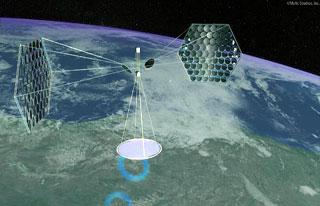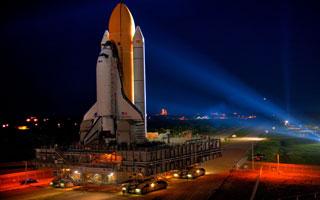
An artistic representation of Space Solar Power. Photo: İMafic Studios, Inc. (National Space Society).
WASHINGTON (PTI): Former Indian President APJ Abdul Kalam and US' prestigious National Space Society are all set to announce their ambitious joint initiative to tap solar power in space.
"The 'Kalam-NSS' Energy Initiative is a transformative idea that can up shift the US and Indian economies by meeting the urgent global need for a scalable, carbon-neutral, green, 24-hr renewable power source," CEO of National Space Society (NSS) Mark Hopkins said.
It is a game-changing technology that addresses energy security, sustainable development, climate change, and multinational cooperation, Hopkins said.
"I am convinced that harvesting solar power in space can bring India and United States of America together in whole new ways.
"And I am certain that harvesting solar power in space can upgrade the living standard of the human race," Kalam said.
Dr TK Alex, Director of the Indian Space Research Organisation (ISRO) and John Mankins, a 25-year NASA veteran, are believed to provide the details via electronic feed.
The next step in the Kalam-NSS Energy Initiative will be a NSS joint Indo-American conference on space solar power at the Von Braun Center in Huntsville, Alabama, on May 18-22 next year.
Space solar power has the potential to reverse America's half-a-trillion dollar balance of payments a year deficit and to generate a new generation of American jobs, a media release said, adding that it is a source whose basic technology is already here.
US has been harvesting solar power in space and transmitting it to earth since 1962, when 'Telstar', the first commercial satellite, went up in orbit. Similarly India has been looking to tap solar energy in space since 1975, when its first satellite, 'Aryabhata A', was introduced. World electricity demand by the year 2035 is projected to increase by 87 per cent.
"By 2050, even if we use every available energy resource we have: clean and dirty, conventional and alternative, solar, wind, geothermal, nuclear, coal, oil, and gas, the world will fall short of the energy we need," Kalam said.
There is an answer- an energy source that produces no carbon emissions, an energy source that can reach to most distant villages of the world, and an energy source that can turn both countries into net energy and technology exporters, the former president added.
 Previous Article
Previous Article Next Article
Next Article









The Indian Air Force, in its flight trials evaluation report submitted before the Defence Ministry l..
view articleAn insight into the Medium Multi-Role Combat Aircraft competition...
view articleSky enthusiasts can now spot the International Space Station (ISS) commanded by Indian-American astr..
view article